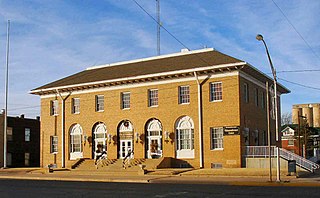Related Research Articles

Woodward County is a county located in the U.S. state of Oklahoma. As of the 2010 census, the population was 20,081. Its county seat is Woodward.

Osage County is the largest county by area in the U.S. state of Oklahoma. Created in 1907 when Oklahoma was admitted as a state, the county is named for and is home to the federally recognized Osage Nation. The county is coextensive with the Osage Nation Reservation, established by treaty in the 19th century when the Osage relocated there from Kansas. The county seat is in Pawhuska, one of the first three towns established in the county. The total population of the county is 47,987.

Noble County is located in the north central part of Oklahoma. As of the 2010 census, the population was 11,561. Its county seat is Perry. It was part of the Cherokee Outlet in Indian Territory until Oklahoma Territory was created in 1890, and the present county land was designated as County P. After the U. S. government opened the area to non-Indian settlement in 1893, it was renamed Noble County for John Willock Noble, then the United States Secretary of the Interior.

Laverne is a town in Harper County, Oklahoma, United States. The population was 1,344 at the 2010 census.
Avant is an incorporated community in eastern Osage County, Oklahoma, United States. The population was 320 at the 2010 census, a decline of 14.0 percent from the figure of 372 recorded in 2000.
Barnsdall is a city in Osage County, Oklahoma, United States. The population was 1,034 at the 2020 census, a decline of 21.9 percent from the figure of 1,325 recorded in 2000.
Burbank is a town in western Osage County, Oklahoma, United States. The population was 141 at the 2010 census, a 9 percent decrease from the figure of 155 recorded in 2000.
Fairfax is a town in Osage County, Oklahoma, United States. The Osage Nation reservation is coterminous with the county. The population was 1,380 at the 2010 census, down 11.3 percent from the figure of 1,555 recorded in 2000. It is notable as the home of world-famous ballerinas Maria and Marjorie Tallchief.
Prue is a town in southern Osage County, Oklahoma, United States. The population was 465 at the 2010 census, up 7.4 percent from the figure of 433 recorded in 2000. The town was named for Henry Prue, who owned the original townsite. Prue was relocated when Lake Keystone was built, and is sometimes called "New Prue".

Shidler is a city in Osage County, Oklahoma, United States. The population was 441 at the 2010 census, a 15.2 percent decrease from the figure of 520 recorded in 2000.
Webb City is an unincorporated town in northwestern Osage County, Oklahoma, United States. The population was 62 at the 2010 census, a 34.7 percent decline from the figure of 95 recorded in 2000. It was named for its founder, Horace Webb, on whose land the town was founded. The Webb City post office opened December 16, 1922.
Wynona is an incorporated town in central Osage County, Oklahoma, United States. It was founded by a local Osage-Cherokee rancher, Antoine Rogers, in 1903. The population was 437 at the 2010 census, a 17.7 percent decline from 531 in 2000.

Cleveland is a city in Pawnee County, Oklahoma, United States. The 2010 census population was 3,251, a decrease of 0.9 percent from the figure of 3,282 recorded in 2000.

Skedee is a town in Pawnee County, Oklahoma, United States. The population was 51 at the 2010 census, a 50 percent decline from the figure of 102 recorded in 2000.

Ponca City is a city in Kay County in the U.S. state of Oklahoma. The city was named after the Ponca tribe. Ponca City had a population of 25,387 at the time of the 2010 census- and a population of 24,424 in the 2020 census.

The Ponca are a Midwestern Native American tribe of the Dhegihan branch of the Siouan language group. There are two federally recognized Ponca tribes: the Ponca Tribe of Nebraska and the Ponca Tribe of Indians of Oklahoma. Their traditions and historical accounts suggest they originated as a tribe east of the Mississippi River in the Ohio River valley area and migrated west for game and as a result of Iroquois wars.
U.S. Route 60 (US-60) is a transcontinental U.S. highway extending from near Brenda, Arizona to Virginia Beach, Virginia on the Atlantic Ocean. Along the way, 352.39 miles (567.12 km) of the route lies within the state of Oklahoma. The highway crosses into the state from Texas west of Arnett and serves many towns and cities in the northern part of the state, including Arnett, Seiling, Fairview, Enid, Ponca City, Pawhuska, Bartlesville, and Vinita. US-60 exits Oklahoma near Seneca, Missouri. In Oklahoma, US-60 has three business routes, serving Tonkawa, Ponca City, and Seneca. The first 60.2 miles (96.9 km) of the route, from the Texas line to Seiling, is also designated as State Highway 51 (SH-51).

Whizbang, officially called Denoya, was an Oklahoma petroleum boom town in the 1920s and 1930s. Located in Osage County, 1.5 miles north and 1.5 miles west of the present town of Shidler, the Whizbang area at its peak had a population of 10,000 persons and 300 businesses and was considered the rowdiest of the many oil field towns in Oklahoma.

The Osage Nation operates seven casinos in Oklahoma, under the name Osage Casino. The 25th largest tribe in the United States, the people are based on their reservation encompassing Osage County, Oklahoma. It is larger than the U.S. states of Delaware and Rhode Island.
The Osage Railway was incorporated in 1921 to accommodate traffic from the oil fields located in the Osage Nation. The first part of its mainline was constructed in 1922 from a connection with the Midland Valley Railroad at Foraker, Oklahoma, to the town of Shidler, Oklahoma, about 10 miles southwest. The line was independently owned from the Midland Valley, but was jointly operated with the Midland Valley and two other lines as part of the Muskogee Roads. Beginning July 2, 1923 and completing in early 1924, the Osage Railway's trackage was extended northwesterly from Shidler through Webb City to Lyman, Oklahoma, about another 6 miles.
References
- ↑ "Lyman, Oklahoma". RoadsideThoughts. Retrieved October 26, 2021.
- ↑ "Ponca City, Oklahoma to Lyman, Oklahoma". Google Maps. Retrieved October 26, 2021.
- 1 2 3 4 5 6 7 8 "Osage County, Oklahoma-Lyman". Geocaching. Retrieved October 26, 2021.
- ↑ "Webb City". Jon D. May, Oklahoma Historical Society. Retrieved October 26, 2021.
- ↑ "Muskogee Company records, Part 1". The University of Texas at Austin, University of Texas Libraries. Retrieved October 25, 2021.